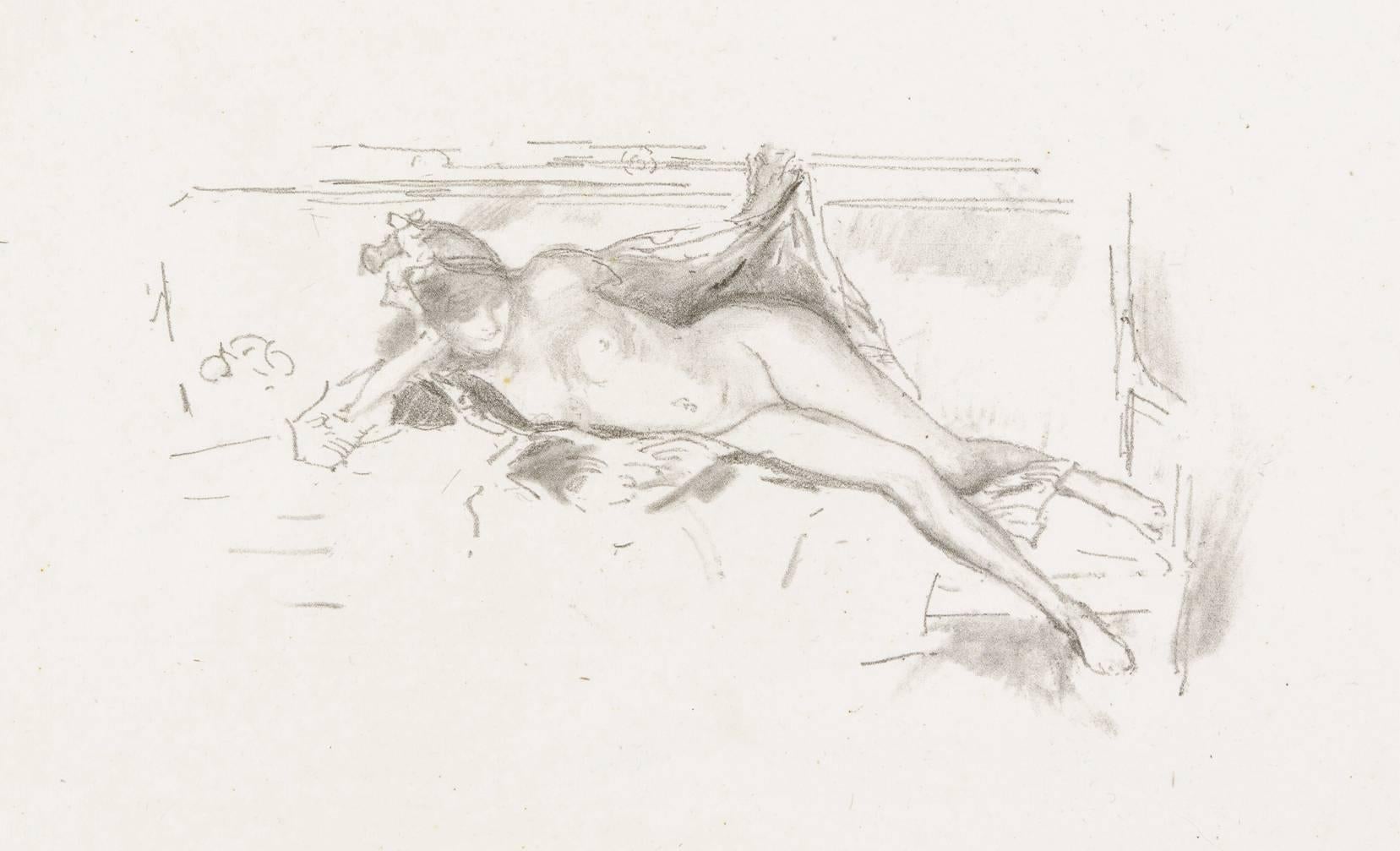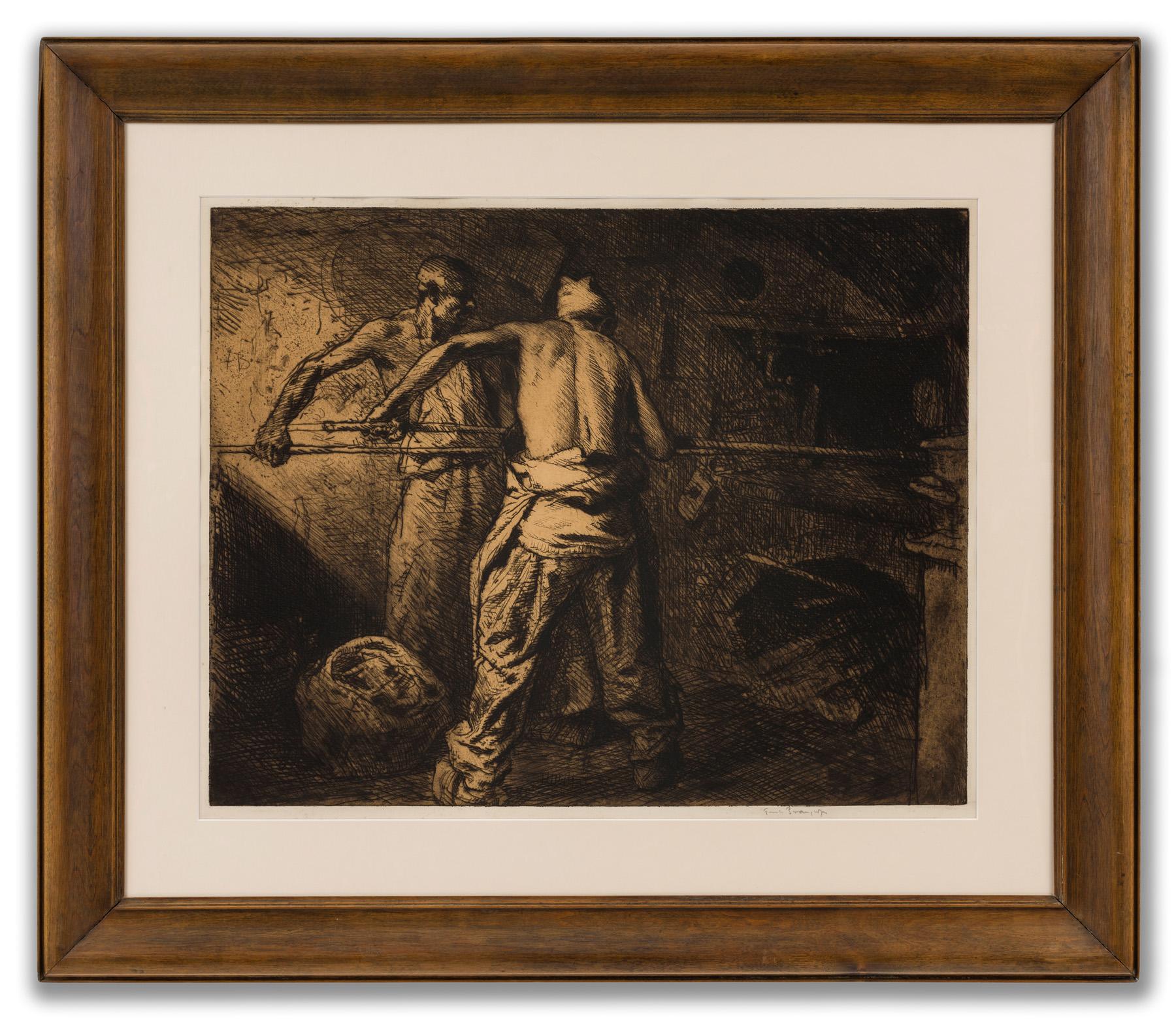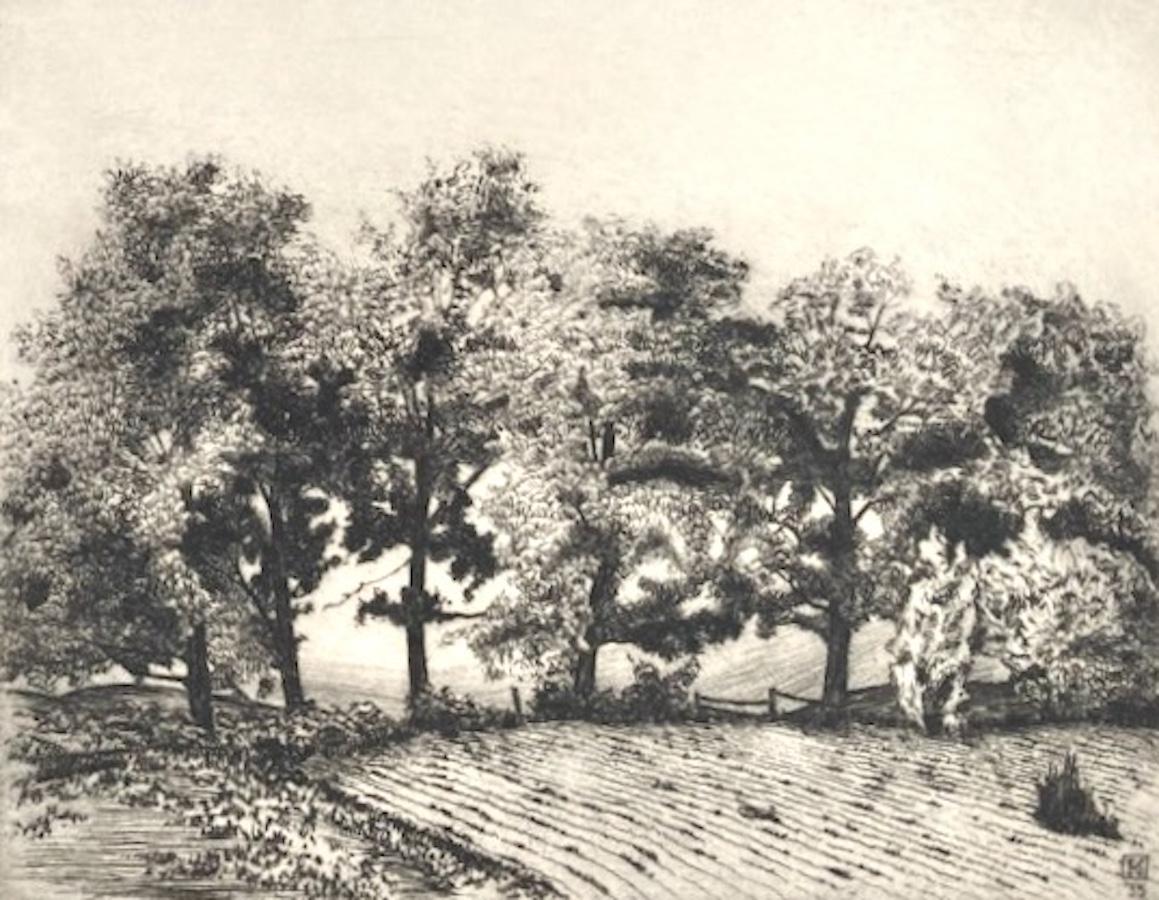Items Similar to Gants de Suede
Want more images or videos?
Request additional images or videos from the seller
1 of 5
James Abbott McNeill WhistlerGants de Suede1890
1890
About the Item
Gants de Suede (Suede Gloves)
Lithograph, 1890
Signed in the stone with the butterfly signature (see photo)
Published in: The Studio 3, No. 13 (16 April 1894)
Printed by Way in an edition of 3000 impressions, with the blind stamp of The Studio, London lower left
Stone polished out in 1904
Condition: Excellent
Image size: 8 1/2 x 4 inches
Sheet size: 11 5/8 x 8 1/4 inches
Reference: Spink/Tadeschi 35, published state
"Gants de Suede is a portrait of Whistler’s sister-in-law, Ethel Birnie Philip. Whistler was apparently pleased with this lithograph, for after a small number of impressions were printed he agreed that it could be published by The Studio, an art magazine that had recently been launched; it appeared as part of a special issue." Harris Schrank
- Creator:James Abbott McNeill Whistler (1834-1903, American)
- Creation Year:1890
- Dimensions:Height: 8.5 in (21.59 cm)Width: 4 in (10.16 cm)
- Medium:
- Movement & Style:
- Period:
- Condition:
- Gallery Location:Fairlawn, OH
- Reference Number:
About the Seller
5.0
Recognized Seller
These prestigious sellers are industry leaders and represent the highest echelon for item quality and design.
Platinum Seller
These expertly vetted sellers are 1stDibs' most experienced sellers and are rated highest by our customers.
Established in 1978
1stDibs seller since 2013
711 sales on 1stDibs
Typical response time: 1 hour
Associations
International Fine Print Dealers Association
- ShippingRetrieving quote...Ships From: Akron, OH
- Return PolicyA return for this item may be initiated within 10 days of delivery.
More From This SellerView All
- CorinneBy Maurice Réalier-DumasLocated in Fairlawn, OHSigned in the stone lower left Edition: 2,000 Provenance: Stedelijk Museum Schiedam, their stamp inside of portfolio, not in Lugt References And Exhibitions: Published...Category
1890s Figurative Prints
MaterialsLithograph
- Innocence in VeniceBy Adolf Arthur DehnLocated in Fairlawn, OHSigned, dated, titled and annotated "100 prints" in pencil by the artist Edition: 100 Printed by George Miller, New York This lithograph was a selection of the Adolf Dehn Pr...Category
1930s Figurative Prints
MaterialsLithograph
- L'ACTEUR . . . . - On voit bien qu'il fait chaud . . . . . . . trois spectateursBy Honoré DaumierLocated in Fairlawn, OHL'ACTEUR . . . . - On voit bien qu'il fait chaud . . . . . . . trois spectateurs dans la salle ..... faut-il commencer ? . . . . LE DIRECTEUR .- Et encore un des trois est le vendeu...Category
1850s Romantic Figurative Prints
MaterialsLithograph
- Le Clown Blanc (The White Clown)By Marc ChagallLocated in Fairlawn, OHLe Clown Blanc (The White Clown) Lithograph, 1964 Unsigned (as issued by DLM) From: Derriere le Miroir Chagall: Dessins et Lavis, Exposition...Category
1960s French School Figurative Prints
MaterialsLithograph
- America's Mom II (Small Leticia)By Sedrick HuckabyLocated in Fairlawn, OHAmerica's Mom II (Small Leticia) Lithograph, 2016 Signed and numbered in pencil by the artist Series: America's Family II (Four images) Edition: 40, of which 20 were retained by the artist This imp 33/40 Printer: James Reed...Category
2010s Contemporary Figurative Prints
MaterialsLithograph
- The TrenchBy James AllenLocated in Fairlawn, OHSigned and annotated in pencil Edition: 30 Provenance: Frac Teck Services, Ft. Worth, TX Part of a series of 12 images commissioned by United States Foundry Company in 1937. Not...Category
1930s Figurative Prints
MaterialsLithograph
You May Also Like
- Nude Model, RecliningBy James Abbott McNeill WhistlerLocated in San Francisco, CAOriginal lithograph printed in black ink on antique laid paper. Signed on the stone with the artist’s butterfly monogram center left. A superb impression of Spink’s third and f...Category
19th Century Aesthetic Movement Figurative Prints
MaterialsLithograph
- Rare Palestine Antique Hebrew Judaica Yahrzeit Synagogue Sign Memorial PlaqueLocated in Surfside, FLCirca 1890-1920. This Neoclassical, Judaic, Egyptian revival, Orientalist Mizrach sign, was produced in British Mandate Palestine by the chromolithograph process at the beginning of the 20th century. It pictures vignettes of holy places. with a hand written memorial. It was for the Tzedakah charity fund for the century-old institutions in Jerusalem: The great "Torah Center Etz Chaim"; a Free Kitchen for poor children and orphans; the famous Bikur Cholim Hospital with its dispensaries and clinics and the only Home for Incurable Invalids in Eretz Israel. They also worked with Arthur Szyk and Alfred Salzmann.. The A.L. Monsohn Lithographic Press (Monzon Press, Monson Press, דפוס אבן א"ל מאנזאהן, דפוס מונזון) was established in Jerusalem in 1892 by Abraham-Leib (or Avrom-Leyb) Monsohn II (Jerusalem, c.1871-1930) and his brother Moshe-Mordechai (Meyshe-Mordkhe). Sponsored by members of the Hamburger family, the brothers had been sent to Frankfurt, Germany in 1890 to study lithography. Upon returning to Jerusalem in 1892 with a hand press, they established the A.L. Monsohn Lithographic Press in the Old City of Jerusalem. According to the Information Center for Israeli Art A.L. Monsohn "created complex decorations for documents and oriental calendars that combined the tradition of Jewish art with modern printing techniques such as photographic lithography, raised printing and gilding." The founders of the Monsohn press produced Jewish-themed color postcards, greeting cards, Jewish National Fund stamps, and maps documenting the evolution of the Jewish settlement in Eretz Israel in the nineteenth-twentieth centuries; religious material such as decorative plaques for synagogues, portraits of Old Yishuv rabbis such as Shmuel Salant, Mizrah posters indicating the direction of prayer for synagogues, memorial posters, and posters for Sukkot booths; color frontispieces for books such as Pentateuch volumes and the early song collections of Abraham Zvi Idelsohn (e.g., Shire Zion, Jerusalem 1908); artistic wedding invitations; and labels, packaging and advertisements for the pioneering entrepreneurs of Eretz Israel. The texts appearing in the Monsohn products were in several languages: Hebrew, Arabic, Yiddish, English, German (e.g., a c1920 trilingual Hebrew-English-Arabic "Malaria Danger" broadside warning the public of mosquitoes spreading malaria). Many of the brilliantly colored postcards and maps can be seen online as can the artistic invitations to his children's weddings which Monsohn published in the Jerusalem Hebrew press. For years, the Monsohn (later, Monson/Monzon) Press was considered the best and most innovative in the country—pioneering in such techniques as gold-embossing and offset printing, among others. Early items for tourists included collections of Flowers of the Holy Land (c. 1910–1918)—pressed local flowers accompanied by scenes from the Eretz Israel countryside and relevant verses from the Bible, edited by Jsac Chagise (or Itzhak Haggis), an immigrant from Vitebsk, and bound in carved olive wood boards. Shortly after World War I Monsohn (now spelled מונזון) used zincography to produce the prints included in the Hebrew Gannenu educational booklets for young children illustrated by Ze'ev Raban of the Bezalel Academy of Art and Design and printed in Jerusalem by Hayim Refael Hakohen (vol. 1, 1919; vols. 2–3, 1920). In 1934 Monsohn moved into the new, western part of Jerusalem, in a shop with four presses and 30 workers, including Abraham-Leib's sons, David, Yosef, Moshe and Shimon, and his daughter Raytse's husband, Abraham Barmacz. The concern did business with all sectors of the city's population, including Arabs, for whom they printed in Arabic. Among their clients were members of the Ginio, Havilio, and Elite families, and Shemen, Dubek, and other renowned national brands, manufacturing products such as wine, candies, oil, and cigarettes. They also printed movie and travel posters, and government posters, postcards and documents, hotel luggage labels...Category
Early 20th Century Aesthetic Movement More Art
MaterialsLithograph
- Men in a BakehouseBy Sir Frank BrangwynLocated in London, GBEtching, signed in pencil (lower right), 51cm x 64.5cm (plate size) (81cm x 94cm framed). British painter, printmaker, draughtsman, and designer, the son of a Welsh architect who specialized in church furnishings and who was working in Belgium at the time of the boy's birth. In 1882–4 Brangwyn served an apprenticeship with William Morris, and like his master he was active in a variety of fields. He was an Official War Artist in the First World War, for example, he was one of the finest draughtsmen of the day and a skilful etcher and lithographer, and he made designs for a great range of objects (furniture, textiles, ceramics, glassware, jewellery, and so on); however, he became best known for his murals. His most famous undertaking in this field was a series of large panels on the theme of the British empire, commissioned by the House of Lords...Category
Early 1900s Aesthetic Movement Figurative Prints
MaterialsPaper, Etching
- Kevin B. O'Callahan, Late Spring (Rochester, NY, area?)By Kevin B. O'CallahanLocated in New York, NY'Late Spring' is in all likelihood picturing the area around O'Callahan's hometown of Rochester, NY, where he lived and spent most of his career. It is signed, titled, and dated, in...Category
1930s Aesthetic Movement Landscape Prints
MaterialsIntaglio
- Kevin B. O'Callahan, Butler Fish (also known at Frog Fish)By Kevin B. O'CallahanLocated in New York, NYThe title appears in pencil at the left bottom margin, in another hand. The print is monogrammed in the plate at the lower right. A Rochester native, Kevin O'Callahan studied at the...Category
1930s Aesthetic Movement Landscape Prints
MaterialsIntaglio
- Kevin B. O'Callahan, (Exotic Temple)By Kevin B. O'CallahanLocated in New York, NYThis (Exotic Temple) is monogrammed in the plate at the lower right. A Rochester, New York native, Kevin O'Callahan studied at the Carnegie Institute and worked on the WPA. He is k...Category
1920s Aesthetic Movement Landscape Prints
MaterialsIntaglio
Recently Viewed
View AllMore Ways To Browse
Picasso Lino Cut
La Double Jay
Lithograph Labisse
Modern Arab
Pitcher And Bowl Stand
What Is Your Commission
Louis Vuitton 3d Print
Russian Stove
Erte Foil
Erte Foiled
Faubourg Hermes Windows
Picasso Barbu
Rachel Castle
Remington Lithograph
Dufy Electricite
Louis Vuitton Commercial 2022
Marc Jacobs Nude
Odilon Redon On Sale





